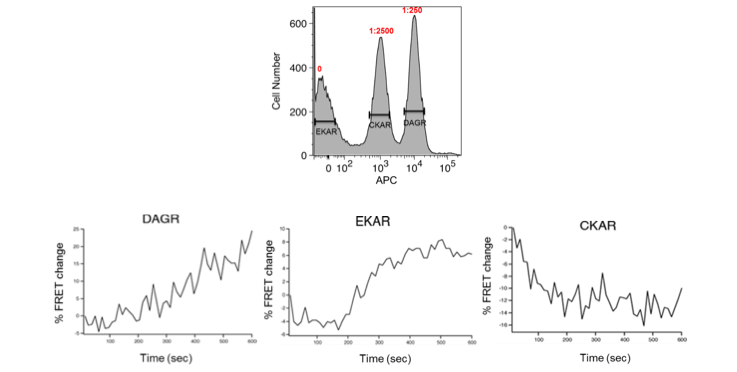Development of Flow-FRET and barcoding system
for kinase cascade study in immune cells
Background
My project is focused on the development of a new multiplexed assay that also relies on flow cytometry for HTS. We became interested in the idea of choosing which specific intracellular targets we want to screen for as opposed to relying on what is found naturally. For this reason, we decided to exploit the diversity of FRET based sensors that have been created in the development of our assay.
Forster Resonance Energy Transfer (FRET) is the process of energy transfer from a donor fluorophore to an acceptor fluorophore. It is a distant dependent process and relies on a spectral overlap of excitation and emission of acceptor and donor, respectively. The FRET sensors used in our method are intramolecular; the donor (CFP) and acceptor (YFP) are bound to the same protein. When the protein undergoes a conformational change upon activation, the fluorophores become closer or further from one another, changing the amount of FRET occurring. This FRET is calculated as YFP emission/CFP emission.
Flow cytometry allows multiple reporters to be measured at once even if the reporters are not spectrally distinct by labeling the cells in a spare channel. Therefore, by using cellular dyes, we can barcode our cells expressing different FRET sensors and be able to tell each sensor apart in a mixed sample.
Method
FRET sensors for different intracellular targets are stably expressed in cells. The cells are loaded with different concentrations cellular dyes. The different loading conditions of the cells correspond to a sensor, allowing us to tell the sensors apart. The loaded cells are then mixed together and stimulated. The mixed population of cells is read on the FACS Aria.

Results and Significance
We currently have working intramolecular FRET sensors for the following cell signaling targets: ERK, PKC, DAG, JNK, PKD, and PKA. We also have a cameleon sensor for measuring increases in intracellular calcium.
Developing a new method for high throughput screening using FRET based sensors in barcoded cells offers the opportunity to screen for multiple intracellular targets at once. This can greatly speed up the screening process and reduce the amount of reagents and cells needed for screening.
Result and Significance
Our phenotypic assay is performed in high-throughput format to screen the molecular library small molecule repository, a chemical library including 364,202 diverse compounds. This identified 2,404 initial hits, 161 confirmed hits, and 75 biologically relevant hits with reasonable dose response. These 75 hits are obtained and further tested for molecular mechanism of action (MMOA) analysis.